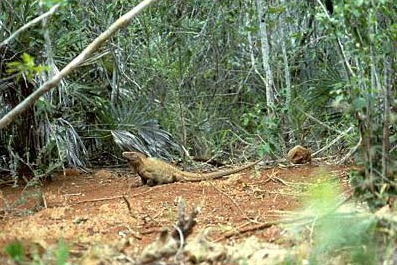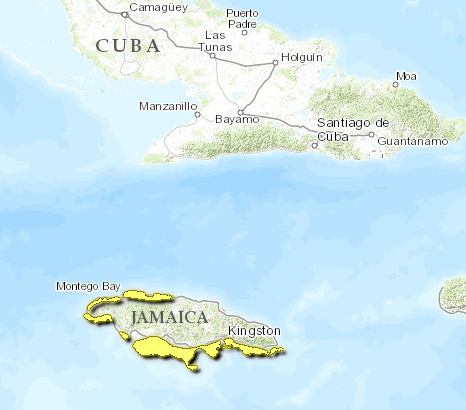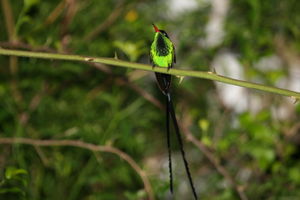Jamaican dry forests
Jamaican dry forests is an ecoregion that covers a minority of the land area of the nation island of Jamaica, which ranks fifth among the Earth's islands in terms of endemic plant life. This ecoregion is home to more than twenty species of endemic birds and when looking at the island as a whole; more than on any other Caribbean Basin island as well as numerous endemic reptiles and amphibians. This ecoregion comprises approximately fifteen percent of the land area on the island and covers most of the dry forests near the coast. The forests in this ecoregion have suffered significant pressure due to deforestation, widespread plantation agriculture and other population-related development. With increased tourism, more emphasis has been directed toward developing a system of protected areas within this ecoregion.
Contents
Location and General Description
Jamaica is the third largest island in the Caribbean (approximately 11,500 square kilometres), located at 18º 15’ N and 77º 30’ W. Jamaica emerged from the ocean in the mid-Miocene, thus it was never connected to any other landmass. The most extensive dry forests on the island are in the limestone formations of the Hellshire Hills and on Portland Ridge; these locations are positioned in the orographic rain shadow of the Blue Mountains, and thus receive much less precipitation than the windward side of the island. Jamaica ranks fifth among the world's islands for amount of endemic plant life. In 1983, less than 67,000 hectares (ha), or six percent of the land area Jamaica was covered in undisturbed natural (Natural environment) forest. In 1995, the World Resources Institute, ranked Jamaica as the country with the highest deforestation rate; although, these figures are considered controversial.
The original lowland forests including the dry forests of this ecoregion have been almost entirely replaced by plantations and artificial savannas. A flat [[coast]al strip] of dry forest surrounds the island, which is narrow in the north. The southern coastal plains are broad, and include flat alluvial areas, and dry hills. In addition, there are small areas of mangrove and herbaceous swamp surrounding this ecoregion and at times falling with in the boundaries. The land surface is two-thirds limestone while the rest is composed of igneous rocks, sedimentary shale and alluvium deposits. Mean annual rainfall varies although it is less than 750 millimetres (mm) along the southern coastal part of this ecoregion.
This ecoregion includes most of the northwestern, western and southern [[coast]al areas] of Jamaica. The habitats of this ecoregion all lie below 213 metres in altitude and have an annual rainfall not usually exceeding 1270 mm. The fundamental vegetation is dry, woodland, considerably modified in many areas by features of the local topography and altered by man’s activities in the more accessible areas. There is considerable variation in species composition, with greater diversity in the less disturbed, more sheltered areas.
Biodiversity Features
Jamaican endemic plant genera include Portlandia and Jacaima , two endemic monotypic genera. The sole representative of genus Jacaima is J. costata, which taxon is in fact endemic to this ecoregion. Of 3003 species of flowering plants recorded from Jamaica, 830 (28%) are endemic; of 579 fern species 82 (14%) are endemic; moreover, within the Bromeliaceae and Orchidaceae, both of which families are richly represented on Jamaica, endemism is 31%. There are a total of 266 vertebrates found in this ecoregion. Several island endemic butterflies including the Homerus Swallowtail (Papilio homerus), the Vulnerable Jamaican Kite (Protographium marcellinus) as well as a multitude of the more than 500 endemic species of Jamaican landsnails, including such as species within genus Pleurodonte and Annularia pulchra are found in this ecoregion.
Birdlife
More than twenty species of endemic birds, out of a total of 113 breeding species, occur on Jamaica. The total number of species present almost doubles in the winter, due to migrants from North America. Most of the endemic species of birds are spread out in forests throughout the island including this ecoregion's dry forests, contain Jamaica’s national bird, the Red-billed Streamertail (Trochilus polytmus) however the similar Black-billed Streamertail (T. scitulus) is confined to the northeastern portion of the island. These bird species require Intact habitat in this dry forest ecoregion as well as in the adjoining moist forest ecoregion. The endemic Jamaican Pauraque (Siphonorhis americanus), was once found chiefly in this ecoregion, but now may be extinct, although some scant evidence suggests it may still be found in very reduced numbers.
Amphibians
The country of Jamaica has 21 endemic amphibian species. Endemic anuran taxa specific to this dry forest ecoregion include the Critically Endangered Portland Cave Robber Frog (Eleutherodactylus cavernicola), a species known only to two caves on the Portland Ridge Peninsula of Jamaica. Other anurans found in this ecoregion are the Critically Endangered Brown Robber Frog (Eleutherodactylus fuscus), a Jamaica endemic with very restricted range; the Endangered Clarendon Parish Robber Frog (Eleutherodactylus grabhami), a Jamaica endemic found on bromeliads or in wet limestone forests; the Vulnerable Cundall's Robber Frog (Eleutherodactylus cundalli), a Jamaica endemic often found in caves; the Endangered Jamaican Snoring Frog (Osteopilus crucialis), a Jamaica endemic found in hollows of dead broadleaf trees or on bromeliads; the Endangered Jamaica Robber Frog (Eleutherodactylus jamaicensis), a Jamaica endemic nearly always associated with bromeliads; the Endangered Little Yellow Treefrog (Eleutherodactylus luteolus), a Jamaica endemic most often found in closed canopy forest; and the Critically Endangered Quick Step Robber Frog (Eleutherodactylus sisyphodemus) .
Reptiles
Jamaica boasts 27 endemic reptile species including Sphaerodactylus parkeri, Cyclura collei and Ameiva dorsalis; several of these species are threatened. The endangered American Crocodile (Crocodylus acutus) occurs in Jamaica mainly along the south coast and is especially abundant in the Black River Morass area.
The endemic, critically endangered Jamaican Rock Iguana (Cyclura collei) survives today only in the Hellshire Hills, a rugged limestone area of 114 km2 fringed by wetlands and beaches located 20 kilometres (km) west of Kingston. The Jamaican iguana declined dramatically during the beginning of the 19th century due to the Introduction (Jamaican dry forests) of the alien species Indian mongoose (Herpestes auropunctatus) and predation by introduced dogs as well as habitat destruction. C. collei was thought to be extinct by 1940, but relict colonies were discovered in the latter part of the century. Ongoing threats to this iguana include charcoal production and human encroachment on the limited dry forest habitat. The Indian Mongoose, was first introduced to Jamaica in 1872 as well as other West Indian Islands. This mongoose is an adaptable species that has effected native vertebrates, especially reptiles and amphibians, and is responsible for the accelerated [[extinct]ion] of numerous endemic species worldwide.
Mammals
There are three endemic bats on Jamaica: Jamaican Fig-eating Bat (Ariteus flavescens), Jamaican Flower Bat (Phyllonycteris aphylla), and Eptesicus fuscus lynni. Other than bat taxa, the sole remaining extant native mammal of Jamaicais the Jamaican Hutia (Geocapromys brownii), was still considered widespread in the dry forests of this ecoregion and moist forests although threatened by hunting and habitat loss. Its current status is unknown.
Current Status
Jamaica has a protected area network more than 40 nominal areas. The majority of these are forest reserves, where until recently, management focused on timber extraction and plantation forestry. However, most parks and reserves are unmanaged and unmonitored with no effective control over timber or charcoal extraction, hunting, and habitat encroachment for housing or agriculture. Funding shortages result in fragmented management and failure of institutional responsibilities .
Enforcement of laws is uneven and unproductive, since the fines for violations of environmental legislation are minimal in many instances. In the 1980s the principal obstacles faced when attempting to develop a working park system included lack of public awareness, political support, protected area legislation, and a park system policy statement. At the same time the need for definition and restriction of management capacity in priority areas developed. Some of these problems have been addressed and a few protected areas established, but some problems persist such as the lack of financial sustainability, management skills, public awareness, and political support.
Types and Severity of Threats
Environmental concerns in this ecoregion are characteristic of other populated Caribbean islands. These include deforestation, soil erosion, population (Human population explosion) pressures, and lack of public awareness concerning conservation. Bauxite (aluminum ore) mining has had a major impact in the island’s forests. Among the most immediate serious threats is deforestation arising from both large and small-scale cultivation, new town and road construction and plans to expand bauxite mining in the Cockpit Country and other parts of central Jamaica. Until recently, inland forests were relatively inaccessible; however, the importation of portable sawmills as well as continued road construction into these areas has led to increased deforestation and selective cutting.
Over one million tourists annually threaten the natural resources, mainly along the [[coast]s], under enormous pressure and in some areas tourist developments are expanding, away from the coasts into the dry forests.
Justification of Ecoregion Delineation
The classification applied here for the dry forests of Jamaica is based on conglomerations of the following dry forest types/formations following the vegetation chart of Brown and Heinman: dry salt marsh and [[coast]al] sands, and dry woodland and confirmed using Grossman et al. classifications.
Further Reading
- Anon. 1989. Conservation of Forest Ecosystems. National Forestry Action Plan Jamaica. Report co-ordinated by C. Weber. 75 pp.
- Braatz, S. M. 1982. Draft environmental profile on Jamaica. Prepared for USAID under contract with US-MAB.
- Brown, F. M., and B. Heineman. 1972. Jamaica and its butterflies. London: E. W. Classey Limited. ISBN: 0900848448
- Caribbean Conservation Association (CCA). 1996. Economic and financial evaluation ofBuccoo Reef Marine Park: Management options. Prepared by Simmons and Associates for the Caribbean Conservation Association.
- Collar, N. J., and P. Andrew. 1988. Birds to watch: the ICPB world checklist of threatened birds. Cambridge: ICBP Technical Publication, No. 8.
- Dalling, J., R. Nelson, and P. Vogel. 1997. Analysis of forest resources and habitat quality in the Hellshire Hills, Portland Bight and Brazilletto Mountains. Report prepared for SCCF/CCAM Foundation.
- Davis, S.D., V.H. Heywood, O. Herrera-MacBryde, J. Villa-Lobos, and A.C. Hamilton, editors. 1997. Centres of plant diversity: a guide and strategy for their conservation (Volume 3. The Americas). Cambridge, U.K.: WWF-World Wide Fund for Nature and IUCN-The World Conservation Union. IUCN. IUCN Publications Unit.
- Davis, S.D., S.J.M. Droop, P. Gregerson, L. Henson, C.J. Leon, J. Villa-Lobos, H. Synge, and J. Zantovska. 1986. Plants in danger. What do we know? Gland, Switzerland and Cambridge, U.K.: IUCN. ISBN: 2880327075
- Downer A. and R. Sutton. 1990. Birds of Jamaica: A photographic field guide. Cambridge: Cambridge University Press. ISBN: 0521383099
- Goreau, J. T., and Discovery Bay Marine Laboratory. 1990. Jamaican parks and protected areas: Urgent need for environmental monitoring. Discovery Bay Marine Laboratory.
- Greenway, J. C. 1967. Extinct and vanishing birds of the world. 2nd Ed. New York: Dover Publications. ISBN: 0486218694
- Grossman, D.H., S. Iremonger, D.M. Muchoney. 1993. Jamaica: map of natural communities and modified vegetation types. Jamaica: a rapid ecological assessment. Phase 1: Anisland-wide characterization of mapping of natural communities and modified vegetation types. The Nature Conservancy, Washington, D.C., USA.
- Hoagland, D. B., G. R. Horst, and C. W. Kilpatrick. 1989. Biogeography and population biology of the mongoose in the Caribbean Basin. Pages 661-634 in C. A. Woods, editor, Biogeography of the Caribbean Basin: Past, present and future. Gainesville, Florida: Sandhill Crane Press, Inc.,
- Mittermaier, R. A., N. Myers, and C. G. Mittermaier. 1999. Hotspots: Earth’s biologically richest and most endangered terrestrial ecosystems. Japan: Toppan Printing Company.
- Oliver, W. L. R. 1982. The coney and the yellow snake: the distribution and status of the Jamaican Hutia Geocapromys brownii and the Jamaican Boa Epicrates subflavus. Dodo. 19: 6-33.
- Stattersfield, A. J., M. J. Crosby, A. J. Long, and D. C. Wege. 1998. Endemic bird areas of the world: priorities for biodiversity conservation. Birdlife Conservation Series 7. Cambridge, U.K.: Birdlife International. ISBN: 1560985747
- Stoffers, A. L. 1993. Dry coastal ecosystems of the West Indies. In E. van der Maarel, editor, Ecosystems of the World 2B: dry coastal ecosystems Africa, America, Asia and Oceania. B.V., Amsterdam: Elsevier Science Publishers. ISBN: 044487349X
- Thorsell, J. W. 1981. Towards a national park system for Jamaica. Natural Resources Conservation Department, Ministry of Mining and Energy.
| Disclaimer: This article contains some information that was originally published by the World Wildlife Fund. Topic editors and authors for the Encyclopedia of Earth have edited its content and added new information. The use of information from the World Wildlife Fund should not be construed as support for or endorsement by that organization for any new information added by EoE personnel, or for any editing of the original content. |


